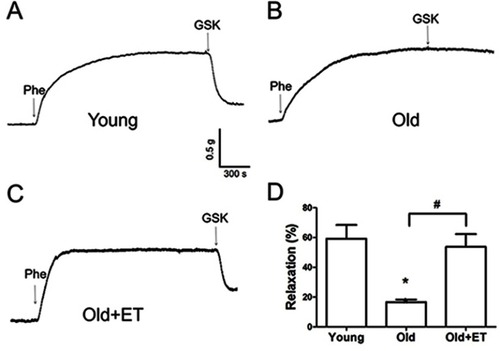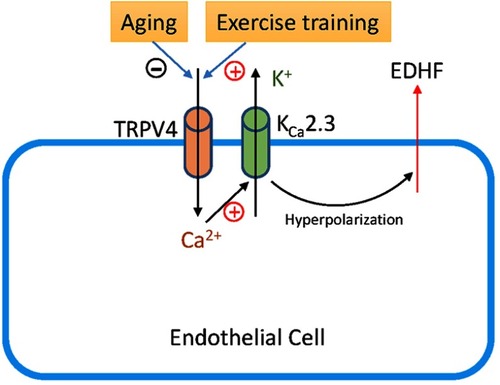Figures & data
Figure 1 Physical interaction of TRPV4 with KCa2.3 in primary cultured rat aortic endothelial cells. Representative images showing co-immunoprecipitation (IP) and immunoblotting (blot) results: (A) immunoblot with anti-TRPV4 antibody; (B) immunoblot with anti-KCa2.3 antibody. Proteins from rat aortic endothelial cells were immunoprecipitated with indicated antibody (+) or preimmune IgG (−); n=3 experiments.
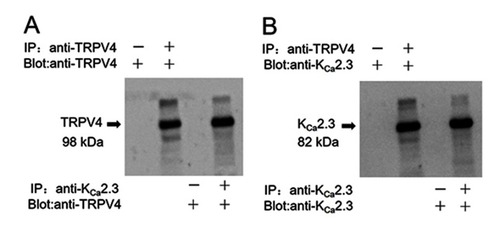
Figure 2 Role of TRPV4-KCa2.3 signaling in acetylcholine (ACh)-induced, endothelium-derived hyperpolarizing factor (EDHF)-mediated relaxation in rat aortic arteries. Representative traces (A, C) and summary data (B, D) for ACh-induced, EDHF-mediated relaxation and the effect of transient receptor potential vanilloid 4 (TRPV4) or small-conductance calcium-activated potassium channel (KCa2.3) inhibition. The EDHF response was induced by 10 μmol/L of ACh (n=10) or 300 nmol/L of the TRPV4 activator GSK1016790A (n=3) in the presence of 7 μmol/L of indomethacin and 300 μmol/L of NG-nitro-L-arginine (n=5). Preincubation with 20 µmol/L of the TRPV4 inhibitor RN1734 (n=4) or with 200 nmol/L of the KCa2.3 inhibitor apamin (n=4) decreased the ACh-induced, EDHF-mediated relaxation in the presence of indomethacin and L-NNA. Values are the mean ± SEM. **P<0.01, ***P<0.001 vs. Ctrl; ##P<0.01 vs. L-NNA + Indo. Phe, indicates phenylephrine; Ctrl, control; Indo, indomethacin; L-NNA, NG-nitro-L-arginine; Apa, apamin; and GSK, GSK1016790A.
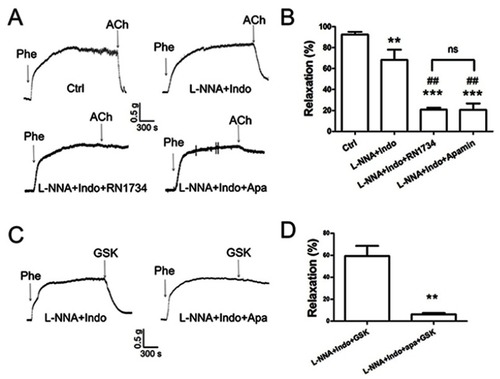
Figure 3 Role of TRPV4-KCa2.3 signaling in age-related decrease in endothelium-derived hyperpolarizing factor (EDHF)-mediated relaxation in rat aortic arteries and the effect of exercise training (ET). Representative traces (A) and summary data (B, D) for acetylcholine (ACh)-induced EDHF-mediated relaxation in the presence or absence of the transient receptor potential vanilloid 4 channel (TRPV4) selective inhibitor RN1734 (20 µmol/L) or the small-conductance calcium-activated potassium channel (KCa2.3) selective inhibitor apamin (200 nmol/L) in aortic arteries derived from rats in the Young, Old, and Old + ET groups. (C, E) Summary data for TRPV4-mediated (C) or KCa2.3-mediated (E) EDHF response in aortic arteries derived from rats in the Young, Old, and Old + ET groups. Values are the mean ± SEM (n=3 experiments). *P<0.05 vs. Young; #P<0.05, ##P<0.01 vs. Ctrl; ƟP <0.05 vs. Old. Phe indicates phenylephrine; Ctrl, control.
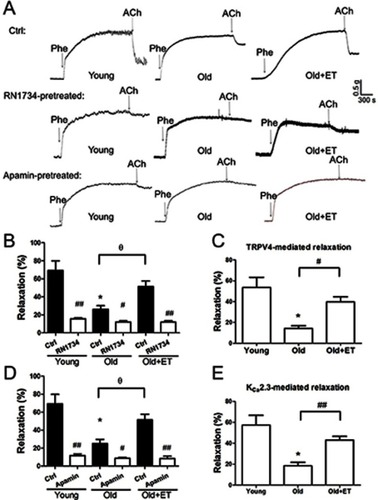
Figure 4 Exercise training (ET) restores the age-related decrease in the GSK1016790A-induced endothelium-derived hyperpolarizing factor (EDHF) response in rat aortic arteries. Representative traces (A–C) and summary data (D) for 300 nmol/L GSK1016790A-induced EDHF-mediated relaxation in aortic arteries derived from rats in the Young, Old, and Old + ET groups. The EDHF response was induced by GSK1016790A (300 nmol/L) in the presence of indomethacin (7 μmol/L) and NG-nitro-L-arginine (300 μmol/L). Values are the mean ± SEM (n=3 experiments). *P<0.05 vs. Young; #P<0.05 vs. Old. Phe indicates phenylephrine; GSK, GSK1016790A.
